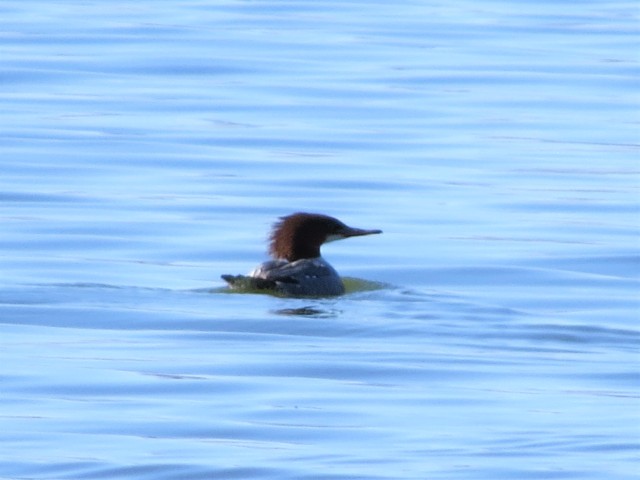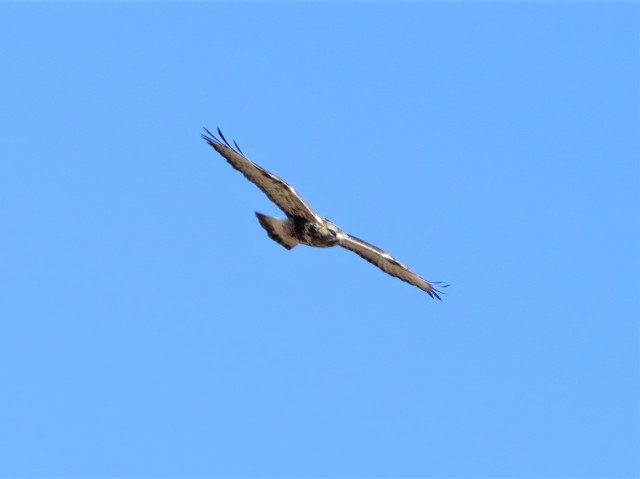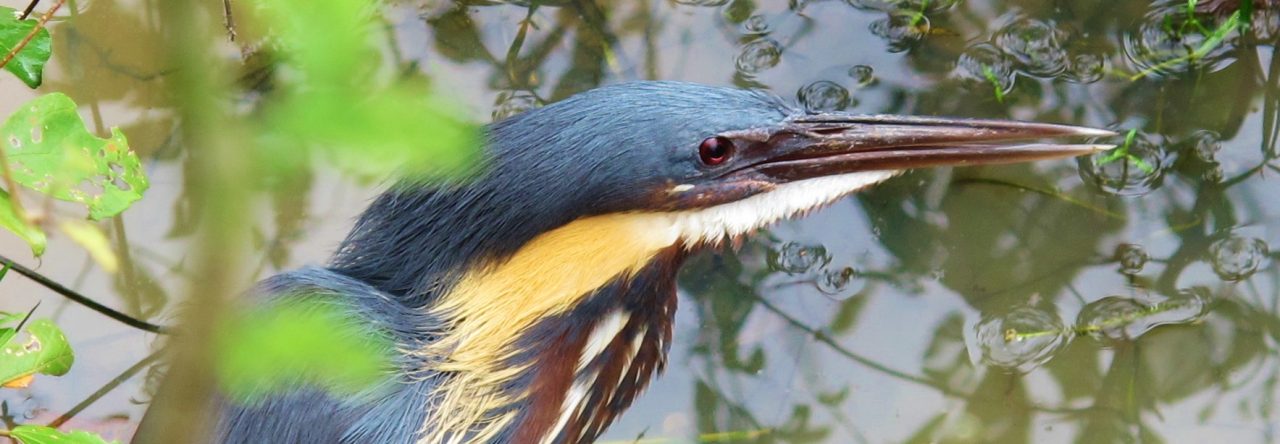
To make absolutely sure I cleared 400 species this year in Texas, I reckoned a final trip out West was needed for some regular winterers in the plains, and a handful of mountain species in the Guadalupes. With a full nine days to play with, I figured I could also fit in my inaugural trip to the Panhandle for some more northerly wintering birds rarely found elsewhere in the state.
The trip got off to an excellent start with a very cooperative Sage Thrasher in Fort Stockton – which turned out to be the only individual of this species I saw.

Next up was Lake Balmorhea, simply a gorgeous location today when the sun was shining, the air was cool and calm, and the water was like glass. Lots of birds were showing in the bushes including some nice western wintering species: Brewer’s Sparrow, Lark Bunting, and Green-tailed Towhee. On the water, a Common Loon loafed near the expected Clark’s and Eared Grebes, and there was a party of three Common Mergansers, a nice bird anywhere in Texas:

I stayed overnight in Van Horn, and headed up to the Guadalupe Mountains before dawn the next day. In the plains, the outside temperature dipped as low as 19F (minus 7C). However, as I gained altitude on the drive up to Frijole Ranch, the temperature climbed, and by first light it was a much more comfortable 36F (2C).

Frijole Ranch was a hive of activity with large numbers of birds coming to drink and bathe in the spring near the old stone house. Highlights included two Juniper Titmice, which visited the area numerous times, but always moved through quickly and did not oblige for a photo. The Mountain Chickadees also wouldn’t sit still for my camera, but I had more luck photographing Steller’s Jay and a female Cassin’s Finch. This is turning out to be a great winter for irruptive montane species in Texas – all of the four birds mentioned above would be much harder to find in the state in a “normal” winter.

Nearby at Pine Springs, a Golden Eagle passed high overhead, two punk-hairstyled Phainopeplas showed well, and a curious Canyon Towhee decided the floorwell inside my car would be a good place to look for food. He was completely unconcerned that I was standing beside the car, less than three feet away.

With most of my mountain targets safely in the bag, and my year list target of 400 already exceeded, I descended to the lowlands to try for some raptors around Dell City during the afternoon. This scruffy little town in the shadow of the Guadalupe Mountains, close to the New Mexico border, is surrounded by mixed farmland and is an excellent location for open country birds in winter.

During the course of the afternoon I had repeated sightings of my two raptor targets, with at least eight individual Ferruginous Hawks and three Prairie Falcons seen. Other sightings included a Merlin, several Sagebrush Sparrows, and singles of both Grasshopper Sparrow and Harris’s Sparrow, both of which are notable here.


The next morning I gradually worked my way west from Van Horn to El Paso with a few target birds in mind, successfully adding Gambel’s Quail, Crissal Thrasher and Anna’s Hummingbird to my list:

With an almost 100% success rate in hitting my target species, by early afternoon I had already decided to drive an additional four hours west to southern Arizona, where at least ten possible lifers lay in wait. By mid-evening I was within 20 miles of my chosen birding location, the Madera Canyon, and found a suitable spot to hunker down and sleep in the car.
The day dawned cloudy and a little breezy, but thankfully the forecast high winds never materialized. Before long I had ratcheted up many of my targets: Bridled Titmouse, Olive Warbler, Red-naped Sapsucker, Painted Redstart and Rufous-winged Sparrow.

The feeding station at Santa Rita Lodge is a fantastic place to while away a couple of hours watching the comings and goings of birds at the feeders – highlights here included Arizona Woodpecker, Cassin’s Finch (a local rarity), and repeated views of several Rivoli’s Hummingbirds, although I have to say the old name Magnificent Hummingbird is more apt for such a large, impressive hummingbird!


Just up the road at the Madera Kubo B+B, I drew a blank with Elegant Trogon but a Hammond’s Flycatcher was seen well and there were several distinctively angry-looking Yellow-eyed Juncos among the numerous Dark-eyed Juncos:

An hour to the south near Sonoita, several Baird’s Sparrows had been reliably coming to a grassland water trough, but mid-afternoon was perhaps not the best time to look for them. I did repeatedly flush a likely suspect from the grass, which flew up from right under my feet but unfortunately disappeared into the grass each time without perching up, despite several attempts to drive it towards one of the few shrubs in the area! Flight views not being enough to clinch the identification, and not wanting to keep disturbing this bird, Baird’s Sparrow unfortunately has to remain “unticked”.

Another species here which never showed on the ground was Chestnut-collared Longspur. However, unlike Baird’s Sparrow the longspurs (about 90 of them in total, in several flocks) showed for prolonged periods in flight in excellent light conditions, enabling most of the ID features to be seen.
The following morning I embarked on another long drive and by early afternoon I was in New Mexico, at a very famous spot where all three North American Rosy-Finch species spend the winter.

Birders make the pilgrimage to Sandia Crest House, a cafe at the summit of a mountain a mile above Albuquerque, where seed is put out for the birds, and with luck all three species (Black Rosy-Finch, Gray-crowned Rosy-Finch, and Brown-capped Rosy-Finch) may be seen in a large mixed flock.

All three Rosy-Finches are elusive, enigmatic denizens of the Alpine zone, and seeing them in summer entails going up to the often inaccessible peaks of North America’s highest mountains. In winter, they deign to descend a little lower, providing birders with a unique opportunity to catch up with them.
Nothing is ever simple in birding, however. After driving 450 miles from southern Arizona, I arrived at the summit of Sandia Crest at about 2.30pm to find the famous cafe closed. The sign on the door cheerily proclaims that the cafe is open every day of the year – apparently with the exception of the one day I decide to visit!

Moreover, it proved impossible to view the Rosy-Finch feeding area without entering the cafe, as the birds are fed on a high terrace. Slightly despondent, I wandered around until I spotted an empty bird table between the cafe and parking lot. I remembered I had some of Whole Foods’ delicious trail mix in my car, the kind with pumpkin and sunflower seeds. Any self-respecting Rosy-Finch would be bound to enjoy that!

And so it proved. Not expecting a miracle, I put out my bait on the bird table and suddenly, a mercurial flock of Rosy-Finches appeared out of nowhere. I was lucky to get all three species in the one flock, including one individual of the rare Hepburn’s race of Gray-crowned:

I celebrated my Rosy-Finch success with an overnight stay in the relative luxury of a Super 8 motel (luxury compared to car camping that is!), and the following morning I enjoyed a walk in the crisp mountain air lower down in the Sandia Mountains. I was heading for one particular spot where Evening Grosbeaks regularly come to drink at a water trough. I didn’t get the grosbeaks, but did have a surprise lifer in the form of a stunning male Williamson’s Sapsucker:

Then I was on the road east again, passing back into Texas around lunchtime, and during the afternoon I started looking for some of my Panhandle targets. American Tree Sparrow and Cackling Goose made it onto the list, and a distant adult Golden Eagle was a nice bird to see in this area. My chosen location for the following morning was Lake Palo Duro, in the far north of the Panhandle just a few miles south of the Oklahoma border. This is a wonderful spot for birding, although the weather was quite seriously cold here with overnight lows around 19F (minus 7C) and a cold breeze blowing.

Unfortunately, the wind increased just an hour after sunrise, making it hard to find any passerines, and perhaps unsurprisingly in these conditions I dipped the Golden-crowned Sparrow that had been reported here on and off for several weeks. All was not lost, however, with numerous American Tree Sparrows at this site, several Harris’s Sparrows, a big flock of Mountain Bluebirds, and nice views of several raptors active later in the morning in the breezy conditions including Ferruginous Hawk, Prairie Falcon and Merlin.


I devoted much of the rest of the day to a hunt for longspurs. Three species – Lapland, McCown’s, and Chestnut-collared – winter in the Panhandle. Longspurs are never easy to find or to get good views of, and although I did find flocks in several locations, the only birds I positively identified were all Lapland Longspurs. One flock in a stubble field numbered some 250 birds, but I managed good views of no more than 10 individuals within this flock, and only very poor photos, as they were very restless and would fly up very regularly and relocate far away. It is highly likely there were a few McCown’s Longspurs among their number, but try as I might, I could not find one.

After another very long drive and a surprisingly good overnight sleep in the car, I found myself in suburban Arlington at first light, where I was lucky to connect with a small flock of regularly wintering Rusty Blackbirds in the parking lot. I then spent four very enjoyable hours at the excellent Fort Worth Nature Center, where several Tundra Swans and a Trumpeter Swan are wintering but often prove very elusive here. Such was the case for me and I didn’t see any swans, but I did enjoy great views of a number of birds I seldom see including Fox Sparrow, Brown Creeper and Golden-crowned Kinglet. No year ticks among them but this is a superb site and I will be sure to return when next in this area.

My final year ticks for the trip were Horned Grebe and Eastern Towhee on the way back to Houston. This has been an exceptional first full year of birding in Texas, and with a lot of persistence and dedication (and driving!) I have managed to see more birds (415 species) than many people have on their lists after years of birding in the state. With an end-of-December trip to the LRGV still to go, I have set myself a new target of 420 species – one which I doubt I will have the opportunity to beat in 2018, but watch this space!











